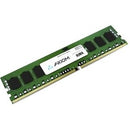Description
16GB DDR4-2933 ECC RDIMM - TAA Compliant
Discover memory designed for reliability, scalability, and peak performance in demanding server environments. The 16GB DDR4-2933 ECC RDIMM from Axiom delivers premium ECC protection, registered buffering, and a tested DDR4-2933 speed to help your enterprise applications run faster, with improved power management and stability. Built for data centers, virtualization hosts, and mission-critical workloads, this module combines cutting-edge DRAM design with robust compliance to ensure consistent operation under load. Whether you’re expanding capacity in a high-transaction database, a growing virtualization cluster, or a compute-intensive workflow, this 16GB DDR4 ECC RDIMM offers the dependable performance you need with the reliability you demand.
- High-performance DDR4 speed with ECC protection: DDR4-2933 MT/s delivers faster memory bandwidth compared with earlier generations, while Error-Correcting Code (ECC) protects against data corruption, helping prevent silent data errors and improving overall system integrity in servers and workstations. This combination is essential for database engines, ERP workloads, and enterprise virtualization where data accuracy and uptime are paramount.
- Registered memory for improved stability and scalability: As a RDIMM, this module uses a registered buffer to reduce signaling loads on the memory controller. This design enhances signal integrity in multi-module configurations, enabling reliable operation in dense server platforms, memory-hungry applications, and large memory footprints typical of virtualized environments.
- 32-bit memory addressing for large-scale deployments: With 16GB per module, you can unlock significantly larger memory footprints in multi-channel configurations. The capacity, combined with ECC and RDIMM architecture, supports expansive databases, in-memory analytics, and virtual machine dense hosts while maintaining consistent performance under heavy load.
- Power management and efficiency: DDR4 memory brings improved power management features, including optimized standby currents and lower on-die termination demands. In data centers, this translates to lower overall power consumption and cooler operation per DIMM, contributing to reduced total cost of ownership (TCO) for server deployments with many memory channels.
- Compliance and reliability for enterprise environments: This module is designed to meet stringent requirements, including TAA compliance for government and regulated industries. The combination of ECC, RDIMM buffering, and DDR4 technology provides a dependable foundation for mission-critical workloads and 24/7 operations.
Technical Details of 16GB DDR4-2933 ECC RDIMM - TAA Compliant
- Memory Type: DDR4 ECC Registered DIMM (RDIMM)
- Capacity: 16GB per module (1 x 16GB configuration commonly available)
- Speed: DDR4-2933 MT/s
- ECC: Registered ECC for data integrity and error correction
- Form Factor: RDIMM, 288-pin DIMM
- Voltage: Standard DDR4 voltage typically around 1.2V (subject to platform specifications)
- Compliance: TAA compliant for use in authorized government and regulated environments
How to Install 16GB DDR4-2933 ECC RDIMM - TAA Compliant
- Power down the server or workstation and unplug it from the power source. Ground yourself to prevent static discharge before handling memory modules.
- Identify the correct memory channel and available RDIMM slot(s) on the motherboard or memory riser card. Check your system’s maintenance or user guide for supported DDR4 RDIMM configurations and memory population guidelines.
- Open the memory slot latch, align the notch on the RDIMM with the slot, and firmly seat the module into the socket. Apply even pressure on both ends until the module is fully seated and the latches click into place.
- Power up the system and enter the BIOS/UEFI to verify that the new memory is detected. For optimal stability, ensure the memory is running in the requested speed (DDR4-2933) and that any required XMP/firmware settings are configured per your platform’s recommendations.
- Run memory diagnostics (such as MemTest86 or your system’s built-in diagnostic tools) to confirm proper operation and error-free performance across all memory channels. If any errors appear, reseat the module or test in alternate slots to rule out slot-specific issues.
Frequently asked questions
- Q: What is 16GB DDR4-2933 ECC RDIMM used for?
- A: It is server-grade memory designed for reliability and data integrity. The ECC and registered RDIMM architecture provide error detection, correction, and stable performance in multi-module configurations for servers, virtualization hosts, and enterprise apps.
- Q: Is this memory compliant with standards required for government and regulated industries?
- A: Yes. The module is TAA compliant, making it suitable for use in government, healthcare, and other regulated environments where approved procurement and traceability are important.
- Q: Will this 16GB module improve my database or virtualization performance?
- A: In many workloads, DDR4-2933 memory with ECC and RDIMM buffering can improve throughput and stability, particularly when running large databases, in-memory analytics, or dense virtualized environments. The exact gains depend on system configuration, workload, and memory pairing.
- Q: How do I know if my server supports ECC RDIMM at DDR4-2933?
- A: Check your server or motherboard vendor’s compatibility list. Most modern servers with DDR4 memory controllers support ECC RDIMM, but you should confirm supported speeds, DIMM types, and maximum memory per channel for your exact model.
- Q: What should I do if the memory is not detected after installation?
- A: Ensure the module is properly seated, verify compatibility with your motherboard, test the RAM in alternative slots, and update to the latest BIOS/firmware. If issues persist, try a different module to determine if the problem is with the module or the slot.
- Q: Can I mix ECC RDIMM with non-ECC memory in the same system?
- A: Mixing ECC with non-ECC memory is generally not recommended and can lead to instability. For best results, use matching ECC RDIMMs across all memory slots, following your vendor’s guidelines for memory population.
Customer reviews
Showing - Of Reviews


